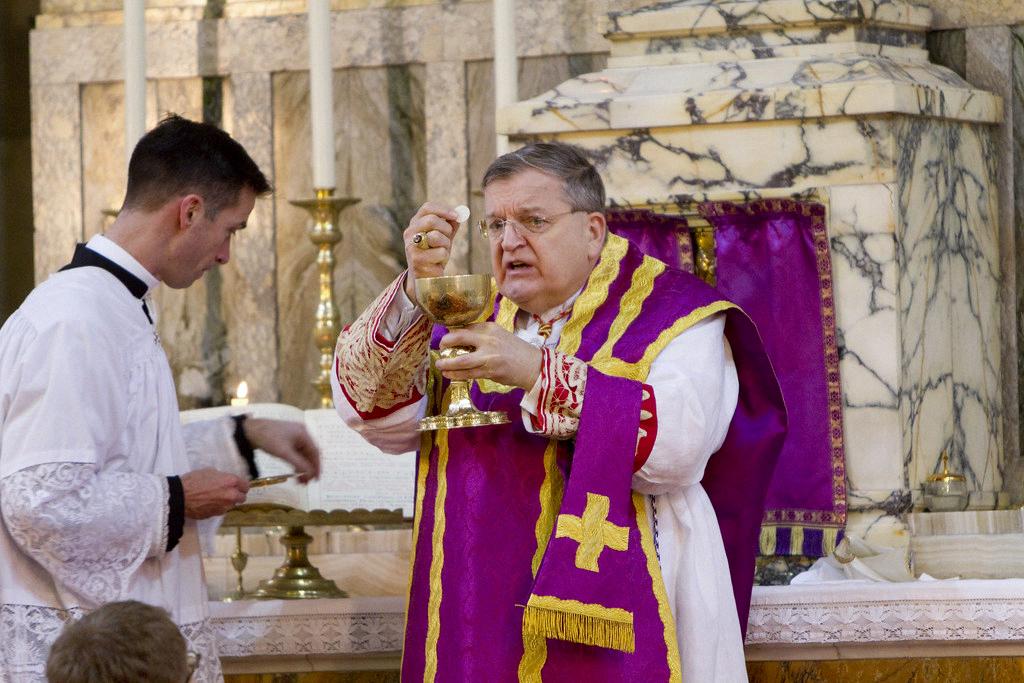Ecce Agnus Dei, a Latin phrase that translates to “Behold the Lamb of God,” is a powerful statement made by St. John the Baptist in the Gospel of John. This statement is significant bcause it refers to the innocence of a lamb and to Christ being a sacrificial lamb after the Jewish religious practice. In this blog post, we will delve deeper into the meaning behind this phrase and its significance in Christian theology.
The phrase “Ecce Agnus Dei” was first uttered by St. John the Baptist when he saw Jesus coming towards him. John was preaching and baptizing people in the Jordan River, and when he saw Jesus, he exclaimed, “Behold the Lamb of God, who takes away the sin of the world!” (John 1:29). This statement is significant because it identifies Jesus as the sacrificial lamb who will take on the sins of the world and offer himself as a sacrifice for humanity’s salvation.
The concept of the sacrificial lamb is deeply rooted in Jewish religious practice. In the Old Testament, the Israelites were commanded to offer animal sacrifices to atone for their sins. The lamb was the most common sacrificial animal, and its blood was thought to represent the cleansing of sin. The lamb was also a symbol of innocence, and its sacrifice was seen as a way to restore the relationship between God and humanity.
In Christian theology, Jesus Christ is seen as the ultimate sacrificial lamb. His death on the cross is understood as the ultimate sacrifice that atones for the sins of humanity. This understanding of Christ as the sacrificial lamb is encapsulated in the phrase “Ecce Agnus Dei.” It is a reminder that Christ’s sacrifice was not just a historical event but a continuing reality that offers salvation to all who believe.
The phrase “Ecce Agnus Dei” is also significant in Christian liturgy. It is often used in the Mass, specifically during the Agnus Dei, a prayer that asks for mercy and peace. The prayer begins with the words “Lamb of God, who takes away the sins of the world, have mercy on us.” These words are a direct reference to the phrase “Ecce Agnus Dei” and serve as a reminder of Christ’s sacrifice and the mercy and peace it offers.
“Ecce Agnus Dei” is a powerful statement that encapsulates the Christian understanding of Christ as the sacrificial lamb who offers salvation to all who believe. It is a reminder of Christ’s sacrifice and the mercy and peace that it offers. The phrase is significant in Christian liturgy and continues to be a central part of Christian theology.
The Meaning of Ecce Agnus
Ecce Agnus is a Latin phrase that translates to “Behold the Lamb” in English. The term is frequently used in Christian theology, paticularly in reference to Jesus Christ. In the Bible, John the Baptist uses the phrase to refer to Jesus when he sees him coming towards him, stating, “Behold the Lamb of God who takes away the sin of the world” (John 1:29). This phrase is a powerful reminder of the sacrificial nature of Jesus’ death and his role as the ultimate sacrifice for the forgiveness of sins. The phrase is also used in liturgical settings, particularly during the Eucharist, where it is used to reference the presence of Christ in the bread and wine. Ecce Agnus is a significant phrase within Christian tradition, representing the ultimate sacrifice made by Jesus for the forgiveness of sins.

Source: commons.wikimedia.org
The Language of ‘Ecce Agnus Dei’
Ecce Agnus Dei is a Latin phrase that translates to “Behold the Lamb of God” in English. Therefore, Ecce Agnus Dei is a phrase in the Latin language. Latin was the language of the Roman Empire, and it continued to be used extensively throughout Europe in religious, scientific, and scholarly contexts until the 18th century. Today, Latin is still studied and used in some academic and religious circles. In the context of Christianity, Latin is often used in liturgy and hymns, and Ecce Agnus Dei is a phrase that is commonly used in Christian worship services.
The Meaning of the Agnus Dei Prayer
The Agnus Dei prayer is a Latin hymn wich translates to “Lamb of God”. It is a part of the Catholic Mass and is sung or recited after the Gloria and before the distribution of Holy Communion. The prayer refers to Jesus Christ as the sacrificial lamb who takes away the sins of the world. It is a plea for mercy and forgiveness, and a request for peace in the world. The prayer is often sung or recited three times, with each repetition increasing in intensity. It is a powerful prayer that has been a part of the Catholic liturgy for centuries and continues to be a central part of the Mass today.
The Purpose of Agnus Dei
Agnus Dei is a choral arrangement of the second movement of Samuel Barber’s String Quartet, Op. 11, which was composed in 1936. Barber created the choral version at the request of his publisher, G. Schirmer, and it was first performed by the Westminster Choir in 1964. The text of Agnus Dei is based on the Latin liturgical text from the Roman Catholic Mass, which translates to “Lamb of God, who takes away the sins of the world, have mercy on us.” The piece has since become a popular and frequently performed choral work, known for its haunting and poignant melody.
The Bible’s Reference to ECCE
The word “Ecce” is a Latin term that means “behold” or “look.” In the Bible, the term is used in the New Testament when Pontius Pilate presents Jesus of Nazareth to the crowd before his crucifixion. The full phrase is “Ecce homo,” which translates to “Behold the man.” Pilate used these words to show the crowd that he had found no fault in Jesus and to appeal to their humanity and compassion. However, the crowd was already filled with anger and hatred twards Jesus, and Pilate’s words did not sway them. The phrase “Ecce homo” has since become a symbol of the suffering and humility of Jesus, as well as a powerful reminder of the injustice and cruelty of the crucifixion.

Source: flickr.com
The Meaning Behind Jesus Being Called ‘Agnus Dei’
Jesus is called Agnus Dei, which means “Lamb of God” in Latin, because of the role he plays in Christian theology. The term is based on the words of John the Baptist, who, upon seeing Jesus, exclaimed, “Behold, the Lamb of God, who takes away the sin of the world!” (John 1:29).
In the Old Testament, lambs were often sacrificed as a symbol of atonement for sins. The Book of Exodus describes how the Israelites were instructed to sacrifice a lamb and smear its blood on teir doorposts as a sign of protection from the angel of death. This sacrifice served as a temporary solution for sin and was a foreshadowing of the ultimate sacrifice that Jesus would make on the cross.
In the New Testament, Jesus is referred to as the “lamb without blemish” (1 Peter 1:19) who was sacrificed once and for all to take away the sins of the world. He is seen as the perfect and ultimate sacrifice for sin, as he was sinless and willingly gave his life for humanity.
Thus, Jesus is called Agnus Dei to emphasize his sacrificial and atoning role in Christian theology. The title is a reminder of the great love that God has for humanity, and the extent to which he was willing to go to save his people from sin and death.
What Language Did Jesus Speak?
Many religious scholars and historians believe that Jesus primarily spoke a Galilean dialect of Aramaic. Aramaic was a language that had spread far and wide through trade, invasions, and conquests, and had become the lingua franca in many parts of the Middle East by the 7th century B.C. It is also believed that Jesus may have been proficient in Hebrew, as this was the language of the Jewish scriptures and religious teachings at the time. Additionally, Jesus may have also known some Greek, as it was the language of the Roman Empire and was widely spoken in the region. However, while there is some debate aout the specific languages Jesus spoke, it is generally agreed that Aramaic was the language he used most frequently in his daily life and in his teachings.
Jesus’ Name in His Native Language
In his native language, Jesus was called “Yeshua”, which is a Hebrew name. It is pronounced as “yeh-SHOO-ah” in Hebrew. The name Yeshua is a shortened version of the Hebrew name “Yehoshua”, which means “The Lord saves”. Yeshua is the equivalent of the English name Joshua. It was a common name in ancient Israel and was given to many boys during that time. Jesus was referred to as Yeshua throughout his life, and it is still the name that is used for him in Hebrew-speaking communities today.
The Name of Jesus in His Language
The name of Jesus in his language was Yeshua or Y’shua. This name is derived from the Hebrew and Aramaic languages and means “salvation” or “deliverance”. In Ancient Greek, the name was rendered as Iēsous (Ἰησοῦς) which is the equivalent of the Hebrew Yeshua. The name Yeshua is etymologically related to another biblical name, Joshua. It is important to note that the name “Jesus” is the English translation of the name Iēsous and has been used for centuries to refer to the religious figure central to Christianity.

Source: artuk.org
The Power of Three Prayers
There are three powerful prayers that are commonly known as the prayer of protection, the prayer of transformation, and the prayer of restoration. The prayer of protection is a powerful prayer that is typically used to invoke divine protection and safeguard against negative energies, evil spirits, and other forms of harm. It is oten recited by individuals who feel the need for spiritual protection in their daily lives.
The prayer of transformation, on the other hand, is a prayer that is used to seek spiritual guidance and transformation. This prayer is designed to help individuals gain deeper insight into their lives, overcome negative habits, and develop a stronger connection with their higher selves. It is a powerful tool that can help individuals overcome personal challenges and spiritual obstacles.
Lastly, the prayer of restoration is a prayer that is used to seek healing and restoration for oneself or others. This prayer is often used to restore physical, emotional, and spiritual health and well-being. It can also be used to help individuals overcome past traumas or emotional wounds and move forward in a positive and healthy way.
These three prayers are powerful tools that can help individuals tap into their spiritual power, seek divine guidance, and overcome personal challenges. Whether it is seeking protection, transformation, or restoration, these prayers can provide support and comfort during difficult times and help individuals connect with their higher selves.
The Four Basic Prayers
The four basic forms of prayer are the Prayer of Blessing and Adoration, Prayer of Petition, Prayer of Intercession, and Prayer of Thanksgiving. The Prayer of Blessing and Adoration is a form of prayer that praises and adores God. It involves acknowledging God’s greatness, goodness, and power, and expressing gratitude for all that He has done. The Prayer of Petition is a form of prayer that involves asking God for what we need, including forgiveness for our sins. This type of prayer is often used to ask for help in difficult situations, guidance, and strength. The Prayer of Intercession is a form of prayer that involves asking God to help others. This type of prayer is often used to ask for healing, protection, and guidance for family members, friends, and oters in need. The Prayer of Thanksgiving is a form of prayer that expresses gratitude for all that God has given and done. This type of prayer is often used to acknowledge God’s blessings and to show appreciation for His love and provision.
Kneeling During the Agnus Dei
According to the General Instruction of the Roman Missal, it is customary for the faithful to kneel after the Agnus Dei, unless the Diocesan Bishop has determined otherwise. In our paticular diocese, the Bishop has not made any such determination, so it is appropriate for us to kneel during this part of the Mass. Kneeling during the Agnus Dei is an expression of our reverence and humility before the Lord, as we prepare to receive the Eucharist. It is also a sign of our unity with the rest of the Church, as this posture is practiced by Catholics around the world. So, to answer the question, yes, we do kneel during the Agnus Dei as part of our participation in the Mass.
Conclusion
Ecce Agnus Dei is a powerful Latin phrase that refers to the Lamb of God, Jesus Christ. This phrase is derived from the Gospel of John, where St. John the Baptist identifies Jesus as the Lamb of God. The phrase reflects both the innocence of a lamb and Christ’s role as a sacrificial lamb for the redemption of mankind’s sins.
The phrase has been used in various Christian traditions, including the Catholic Church, and has inspired numerous musical compositions and liturgical chants. One of the most famous musical compositions inspired by this phrase is Barber’s Adagio for Strings, which has becme an iconic piece of classical music.
Ecce Agnus Dei remains an essential part of Christian theology and liturgy, emphasizing the sacrifice of Christ and the promise of redemption. It is a reminder of the central message of the Christian faith and a symbol of hope for believers worldwide.
